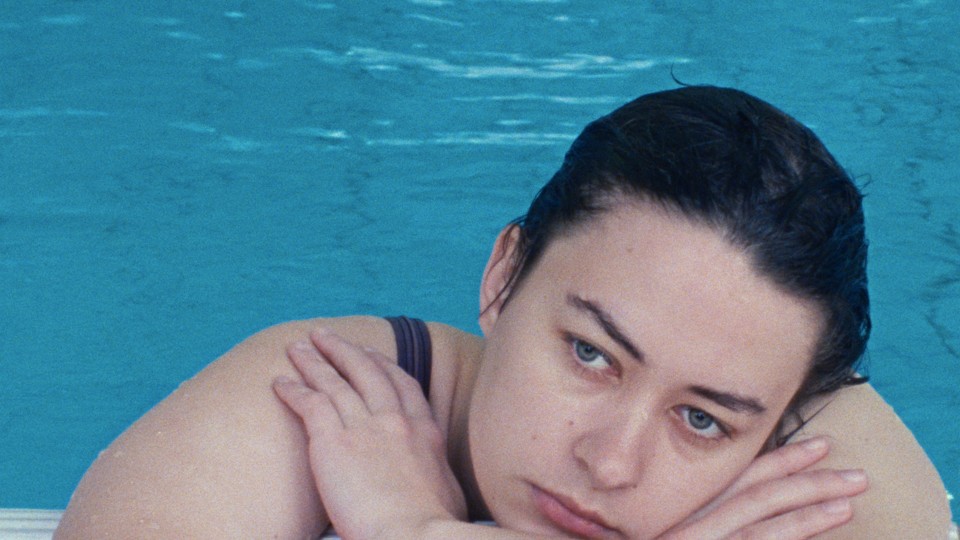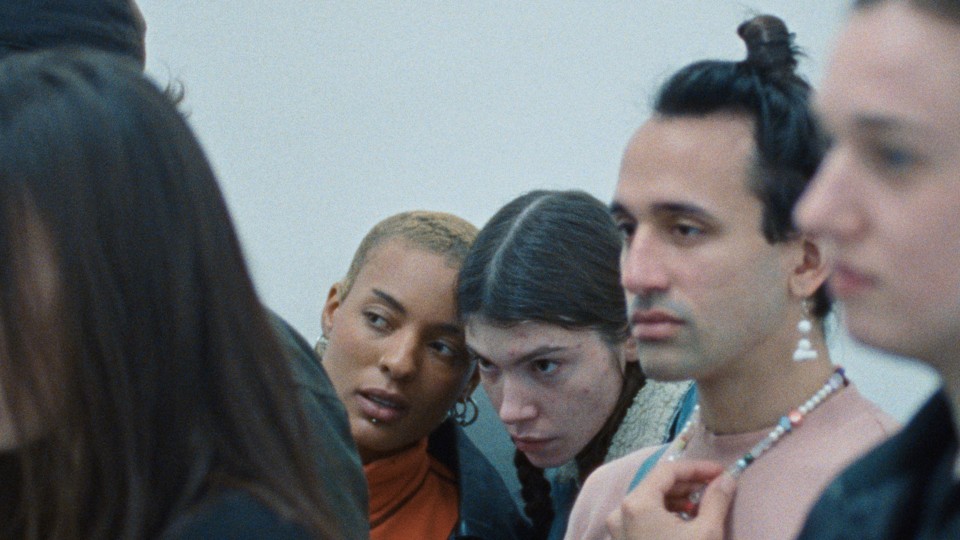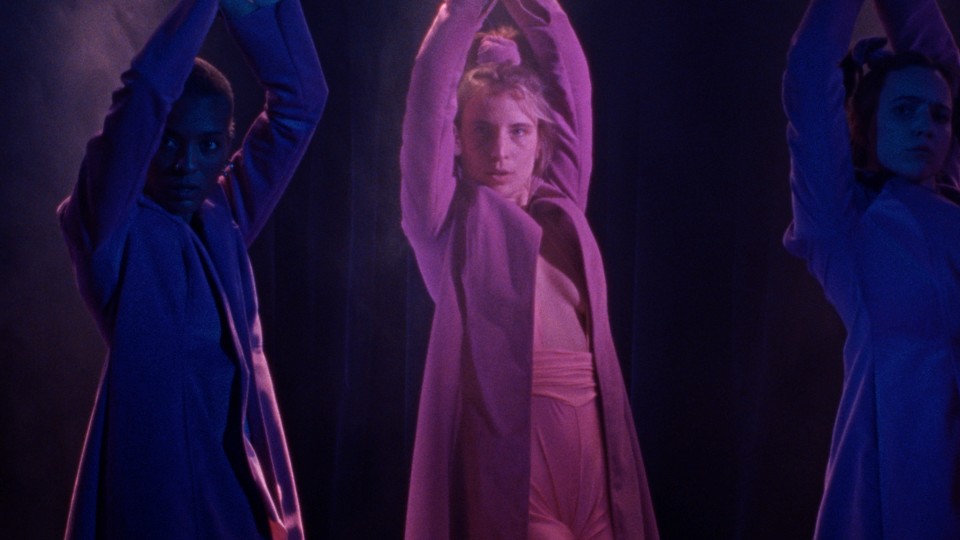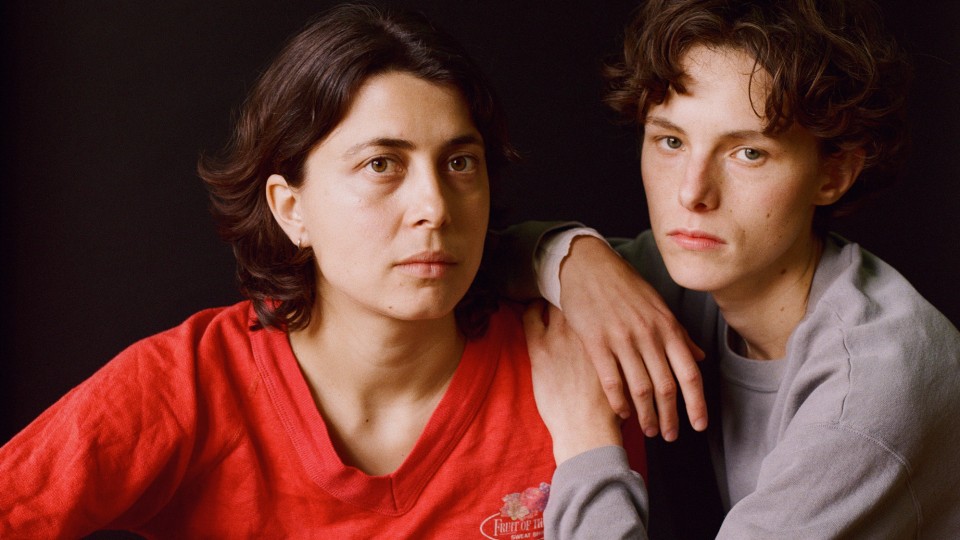Two young protagonists and everyday life. Being alone at home. Being alone in public, outdoors. Sometimes looking for a connection
– only to retreat again soon afterwards. In their second feature film, b l u i s h, Lilith Kraxner and Milena Czernovsky explore an intangible state of being in-between after a period of social isolation.
While their sensory images trace the vague moods of their characters, the fluid boundaries at the edges of the frame initiate
a multi-layered encounter with other media and art forms.
Were the colour blue, and its associations, the first source of inspiration for blusih?
MILENA CZERNOVSKY: The focus wasn’t on the colour blue from the beginning. It was only during the editing process and the title search that
we noticed how present that colour is in the film. For us, "bluish" describes a mood that we want to talk about.
LILITH KRAXNER: We found it difficult to come up with a title that gets to the heart of the content, because it's so much about an in-between,
a feeling, an atmosphere. When I read Bluets by Maggie Nelson, parts of the book reminded me of sequences from our film. On top of that, the artists in the band Les Reines Prochaines (with whom we also collaborated for b l u i s h) told us that they often dream their titles.
MILENA CZERNOVSKY: And that's how it happened. I dreamt of “bluish”.
You depict your characters through minimal everyday events and everyday gestures. How do you create a screenplay? Is it a
long process of reduction in an attempt to dispense with narrative convention?
LILITH KRAXNER: Actually, it’s more the opposite. Our method of writing stories or characters consists of picking up on exactly these individual
moments from everyday life. With Milena and me, a lot arises in conversation, in the exchange of observations about situations
that we perceive in our environment.
MILENA CZERNOVSKY: We collect a large number of these moments. From this collection, we try to develop characters who embody these moods well,
and a dramaturgy. It was clear from the beginning that this time we wanted to talk about at least two characters and the ways
they overlap.
Does the work with the actors start at a very early stage? How did the collaboration with Leonie Bramberger and Natasha Goncharova
come about?
MILENA CZERNOVSKY: The collaboration with Leonie came about through a casting process, during the course of which a lot of character development
also took place. We always try to develop roles together with our actors, and we find that good preparation is important to
us, so they are able to improvise in set scenes.
LILITH KRAXNER: During the script development, we met Natasha at a film festival and felt the desire to work with her, so we developed a
second character which is inspired by her. We tried to incorporate her personal story without doing so too superficially.
In BLUISH there are conversation situations, such as a phone call, the translation of a speech, a Zoom lecture – but hardly
any conversations in the sense of verbal exchanges. Do you try to avoid classical dialogue as a dramaturgical device?
MILENA CZERNOVSKY: We employ a lot of facial expressions, gestures and supposedly casual situations as narrative methods. We’re less interested
in "goal-oriented" dialogue that serves up all the information for the audience; instead, we try to open up space for their
own interpretations.
LILITH KRAXNER: Writing dialogue doesn’t correspond with our way of working. Words are often very concrete. We convey a lot through materials,
surfaces and haptics. Proceeding from a time after isolation due to the Covid pandemic, we wanted to portray moments of slow
rapprochement and re-establishment in social structures. Ambivalences in the search for closeness ...
MILENA CZERNOVSKY: ... the need to feel oneself and the attempt to find a counterpart in objects, screens and digital space.
The main characters are self-absorbed. Does the colour blue also refer to their mental state and quite consciously to a (post-)
Covid mood?
MILENA CZERNOVSKY: It was clear to us that we shouldn’t exclude the pandemic. During the time we developed and wrote the screenplay – that was
in 2022 – our experiences and our environment were shaped by it. It would have been strange not to include this subject, but
it wasn’t our intention to tell a (post-)Covid story explicitly, either.
LILITH KRAXNER: We wanted to capture a "now" that is difficult to pin down. It was an attempt to better understand a time by collecting moments.
One crucial element in b l u i s h concerns dissolving or crossing boundaries. The falling asleep meditation is just one of the situations where perception
dissolves, and it’s unclear whether this applies to the protagonist or extends beyond the screen to the audience.
MILENA CZERNOVSKY: We work with different levels in order to play with or question the role of the audience. People come to the cinema expecting
to see a film, but during the course of that experience they also become the audience of a performance or participants in
a meditation, or they find themselves in a computer game.
LILITH KRAXNER: Through collaboration with artists in other fields, we were able to broaden our perspective and experiment with other forms
of media.
How did the selection of the artists come about?
LILITH KRAXNER: Most of the artists who appear in b l u i s h are from our environment, people we wanted to collaborate with. We respect their work and wanted to unite them in a film.
The film begins with the band Les Reines Prochaines and their song Bist du klein, bist du groß (Are You Small, Are You Big). They re-recorded their song, which originally dates back to the 90s, for b l u i s h.
MILENA CZERNOVSKY: The excerpt from Rebecca Merlic’s work Glitchbodies takes us through a virtual, empty shopping centre and is part of her experimental film of the same name. Rebecca transfers
her protagonists into virtual spaces via 3D scans and also does that with Leonie Bramberger for b l u i s h. In the "real" shopping centre, our protagonist is drawn into the depths of Katrina Daschner's Seas of Pearls. The performance collective ZAK | Center for Antidisciplinary Art performs an excerpt from their piece UFO|ultra fett original.
In b l u i s h there is an interesting confrontation between analogue film material and virtual worlds. What was the thinking behind this?
LILITH KRAXNER: For us, analogue film is a medium, but not one intended to remind us of a bygone era. It was important to us to anchor the
plot strongly in the here and now.
MILENA CZERNOVSKY: Screens are such a ubiquitous part of our everyday lives. So we wanted them to feature here, to tell stories and to help shape
them. The transfer to 16 mm film stock gives the smooth digital world a feel.
Antonia de la Luz Kašik is your cinematographer here, as she was on your debut film Beatrix. What connects you to her?
MILENA CZERNOVSKY: The basis of our collaboration is essentially a trusting relationship going back a very long time. Lilith and Antonia met
at the Friedl Kubelka School for Independent Film. While making Beatrix, our first feature film, the three of us developed a visual language together. We asked ourselves how we wanted to use images
as narrative devices and set down very clear principles about how to do that: we try to have scenes with only one image, or
very few. The action may also take place outside the frame. We want to give space to the unseen, the unheard, the unformulated.
To leave gaps that offer the audience space for their own experiences, feelings and reflections. We work with very little
camera movement, even though there is a first tracking shot in b l u i s h.
LILITH KRAXNER: We also work without additional light; not everything always has to be perfectly lit. Just as in real life, it can be dark
sometimes.
MILENA CZERNOVSKY: Shooting on 16 mm film has proven to be a good idea, because our way of working is very strongly influenced by it. We prepare
thoroughly, and we’re very focused when we’re filming. The limitation of the material, knowing that you can’t repeat scenes
endlessly, brings a different presence to the moment.
You put an emphasis on very long shots.
MILENA CZERNOVSKY: The length of the shots also results from our approach of not explaining everything by means of cuts and reverse shots. We
want to give our viewers the freedom to decide for themselves what they pay attention to. Restricting ourselves to only two
lenses also has a direct effect on the composition of the shots, which is partly a consequence of the space available in the
room.
Showering, washing, swimming in a pool or lake. What role does water play in your film?
MILENA CZERNOVSKY: Overall, we were very interested in aspects of physical perceptions and nuances of feeling oneself, along with a yearning
for touch and the search for that. In this context, water made sense for us.
LILITH KRAXNER: We perceive the state of fluidity, of morphing into different forms, as a metaphor that is very appropriate to bluish.
Is the state of indecision, of dissolving boundaries, of flowing, something that you perceive strongly around you? Possibly
also as a departure into new possibilities (of storytelling)?
LILITH KRAXNER: From the outside, this state might be attributed to a generation, but I perceive it more as a "now". It's nice to see that
boundaries are dissolving and spaces are opening up in between. I think these ambivalences can be unsettling, but they also
possess huge potential.
MILENA CZERNOVSKY: It was clear to us that we didn't want to talk about a resolution or a solution, and that we didn't want to end the film with
a conclusion. The aim is to tell the story of a section that is apparently chosen at random.
LILITH KRAXNER: I don't think it was ever a conscious goal for us to find a "new" narrative style. Maybe it has more to do with the fact
that neither of us studied at a "classic" film school. It can also be helpful not to be so strongly influenced by certain
narrative models or patterns of composition. Perhaps you can also find yourself more freely in your own narration. The situation
where there are at least two of us – often four, with our cinematographer Antonia Luz Kašik and our assistant director and
dramaturgical and content-related consultant Lara Bellon – results in an exchange that is very creative. In a collective,
it is simple to remain more open to form.
Interview: Karin Schiefer
June 2024
Translation: Charles Osborne








